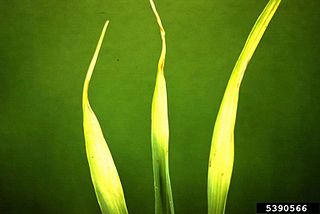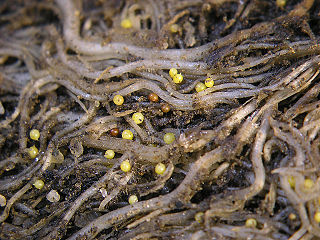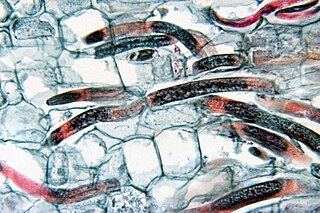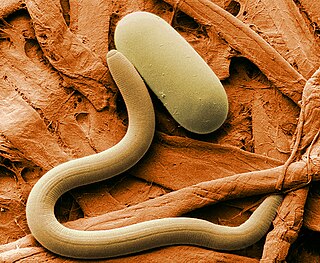 W
WThis article is an attempt to list all agricultural pest nematodes. Species are sorted in alphabetical order of Latin name.
 W
WAnguina is a genus of plant pathogenic nematodes.
 W
WAnguina agrostis is a plant pathogenic nematode.
 W
WAphelenchoides besseyi is a plant pathogenic nematode. It is sometimes referred to as rice white tip, spring dwarf, strawberry bud, flying strawberry nematode or strawberry crimp disease nematode. This foliar nematode is found in Africa, North, Central, and South America, Asia, Eastern Europe, and Pacific islands.
 W
WAphelenchoides ritzemabosi is a plant pathogenic nematode. It was first scientifically described in 1890 in England. This nematode has a wide host range. Among the most important species affected are Chrysanthemums and strawberries. A. ritzemabosi is a migratory foliar feeding nematode. It can feed both ectoparasitically and endoparasitically, with the later causing the most significant damage. When adequate moisture is present, this nematode enters the leaves and feeds from inside the tissue. Typical damage is characterized by necrotic zones between the veins of the leaves. Its lifecycle is short; only ten days from egg to mature adult. A single female can lay as many as 3,500 eggs. This pest can be difficult to control. Host plant resistance, hot water treatments, and predatory mites are recommended.
 W
WDitylenchus is a genus of plant pathogenic nematodes.
 W
WDitylenchus dipsaci is a plant pathogenic nematode that primarily infects onion and garlic. It is commonly known as the stem nematode, the stem and bulb eelworm, or onion bloat. Symptoms of infection include stunted growth, discoloration of bulbs, and swollen stems. D. dipsaci is a migratory endoparasite that has a five-stage lifecycle and the ability to enter into a dormancy stage. D. dipsaci enters through stomata or plant wounds and creates galls or malformations in plant growth. This allows for the entrance of secondary pathogens such as fungi and bacteria. Management of disease is maintained through seed sanitation, heat treatment, crop rotation, and fumigation of fields. D. dipsaci is economically detrimental because infected crops are unmarketable.
 W
WGlobodera rostochiensis, commonly known as the golden nematode, golden eelworm or yellow potato cyst nematode, is a plant pathogenic nematode. It is a pest of plants in the family Solanaceae, primarily infesting potatoes and tomatoes, as well as a variety of other root crops.
 W
WHeterodera avenae, the cereal cyst nematode or European cyst nematode, is a plant pathogen and an obligate parasite of cereal crops including barley, oats, wheat and rye. Cereal crops infected with this nematode are more susceptible to infection by fungal diseases such as rhizoctonia root rot.
 W
WMeloidogyne arenaria is a species of plant pathogenic nematodes. This nematode is also known as the peanut root knot nematode. The word "Meloidogyne" is derived from two Greek words that mean "apple-shaped" and "female". The peanut root knot nematode, M. arenaria is one of the "major" Meloidogyne species because of its worldwide economic importance. M. arenaria is a predominant nematode species in the United States attacking peanut in Alabama, Florida, Georgia, and Texas. The most damaging nematode species for peanut in the USA is M. arenaria race 1 and losses can exceed 50% in severely infested fields. Among the several Meloidogyne species that have been characterized, M. arenaria is the most variable both morphologically and cytologically. In 1949, two races of this nematode had been identified, race 1 which reproduces on peanut and race 2 which cannot do so. However, in a recent study, three races were described. López-Pérez et al (2011) had also studied populations of M. arenaria race 2, which reproduces on tomato plants carrying the Mi gene and race 3, which reproduces on both resistant pepper and tomato.
 W
WMeloidogyne incognita, also known as the "southern root-nematode" or "cotton root-knot nematode" is a plant-parasitic roundworm in the family Heteroderidae. This nematode is one of the four commonest species worldwide and has numerous hosts. It typically incites large, usually irregular galls on roots as a result of parasitism.
 W
WParalongidorus maximus is a plant pathogenic nematode infecting hemp.
 W
WParatylenchus hamatus, the fig pin nematode, is a species of migratory plant endoparasites, that causes lesions on plant roots resulting in symptoms of chlorosis, wilting and ultimately yield losses. They move and feed on different parts of host tissue throughout their life cycle in order to find enough susceptible host tissue to survive and reproduce. A wide range of host plant species are susceptible to the fig pin nematode, including many valuable fruit and vegetable crops such as figs, carrots and celery. They are also commonly found associated with woody perennials in California. P. hamatus inhabits soils in both Europe and North America, and was originally isolated from fig in central California in 1950.
 W
WPotato root nematodes or potato cyst nematodes (PCN) are 1-mm long roundworms belonging to the genus Globodera, which comprises around 12 species. They live on the roots of plants of the family Solanaceae, such as potatoes and tomatoes. PCN cause growth retardation and, at very high population densities, damage to the roots and early senescence of plants. The nematode is not indigenous to Europe but originates from the Andes. Fields are free from PCN until an introduction occurs, after which the typical patches, or hotspots, occur on the farmland. These patches can become full field infestations when unchecked. Yield reductions can average up to 60% at high population densities.
 W
WRadopholus similis is a species of nematode known commonly as the burrowing nematode. It is a parasite of plants, and it is a pest of many agricultural crops. It is an especially important pest of bananas and citrus, and it can be found on coconut, avocado, coffee, sugarcane, other grasses, and ornamentals. It is a migratory endoparasite of roots, causing lesions that form cankers. Infected plants experience malnutrition.
 W
WThe soybean cyst nematode (SCN), Heterodera glycines, is the most devastating pest to crop yields in the U.S., targeting the roots of soybean and other legume plants. When infection is severe SCNs cause stunting, yellowing, impaired canopy development, and yield loss. The symptoms caused by SCNs can go easily unrecognized by farmers - in some cases there are no warning symptoms before a loss of 40% of the yield. Due to the slight stunting and yellowing, many farmers may mistake these symptoms as environmental problems when in fact they are SCNs. Due to the fact that soybean cyst nematodes can only move a few centimeters in the soil by themselves, they mostly are spread via tillage or plant transplants. This area of infection will look patchy and nonuniform making diagnosis more difficult for farmers. They can be seen in the roots of summer soybean plants if the roots are taken out very carefully and gently washed with water. The egg masses should be seen as bright white or yellow "pearls" on the roots. The later the roots are pulled the harder it will be to diagnose due to the SCNs female dying and turning a much darker color, forming a "cyst". The best way to know if a field is infected by soybean cyst nematodes is to take a soil sample to a nematologist.